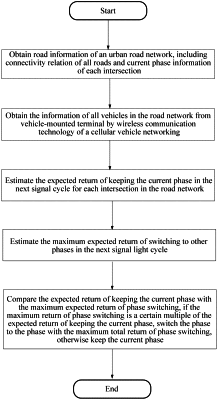| CPC G08G 1/083 (2013.01) [G08G 1/0112 (2013.01); G08G 1/0125 (2013.01); G08G 1/0145 (2013.01); G08G 1/08 (2013.01)] | 9 Claims |

|
1. A traffic light control method for an urban road network based on expected return estimation, comprising:
step 1, obtaining road information of the urban road network, comprising connectivity relation of all roads and current traffic light information of intersections,
wherein each road comprises lanes of three directions: turning left, going straight or turning right;
wherein a traffic light at each intersection comprises four phases: phase 1: turn left on a South-North direction, phase 2: go straight on the South-North direction, phase 3: turn left on a West-East direction, and phase 4: go straight on the West-East direction; and wherein the road information comprises:
a length of a road, a maximum speed limit of all roads which are the same, and a distance between a tail of a current road fleet and an upstream intersection;
step 2, obtaining information of all vehicles in the urban road network from vehicle-mounted terminals by Cellular Vehicle Networking (Cellular-V2X or C-V2X) wireless communication technology, comprising an instantaneous speed of a vehicle and a position on the road expressed as a distance from a last intersection; and
step 3, obtaining current phase information for each intersection in the urban road network,
calculating a total expected return of all incoming lanes that keep a current phase in a next traffic light cycle and a maximum total expected return of all incoming lanes that switch to the other three phases, and selecting an optimal phase after comparison;
when an executed phase in the next traffic light cycle is the same as the current phase, a green light duration of the vehicle being T; and
when the executed phase in the next traffic light cycle is different from the current phase, the green light duration of the vehicle being T-t, where t is a red light duration when a phase is switched;
wherein calculating the total expected return of all incoming lanes comprises:
(3.1) multiplying by a road priority index, a sum of a timely driving distance of a vehicle in a lane and a future driving distance of the vehicle, as an expected return of each incoming lane, and
summing the expected returns of all incoming lanes as a total expected return of a certain phase;
wherein calculating the timely driving distance of the vehicle comprises:
calculating a distance and time that the vehicle needs to travel to reach an intersection according to a driving speed of the vehicle, an acceleration of the vehicle, the maximum speed limit of the road, the length of the road and the distance from the upstream intersection; and
calculating, for all vehicles capable of passing through the intersection, a driving distance of the vehicle within the green light duration;
(3.2) adding a distance that the vehicle needs to travel to reach the intersection calculated in step (3.1) to a length of a road of an outgoing lane and subtracted a queue length of the outgoing lane corresponding to a direction of turning left, going straight or turning right;
determining whether an obtained result is less than the driving distance of the vehicle within the green light duration;
if not, the timely driving distance of the vehicle being the driving distance of the vehicle within the green light duration, and the future driving distance of the vehicle being 0; and
if yes, the timely driving distance of the vehicle and the future driving distance of the vehicle being calculated as follows:
drivedistance-f=d+L2−qf
 where drivedistance-f represents the timely driving distance of the vehicle in the outgoing lane, fUturedistance-f represents the future driving distance of the vehicle in the outgoing lane, wherein the outgoing lane comprises lanes in three directions: turning left, going straight or turning right, which is represented by f, and the vehicle enter one of the lanes with a certain probability; qf represents the queue length of the outgoing lane; d is the distance that the vehicle still needs to travel to reach the intersection, L2 is the road length of the outgoing lane, and DT is the driving distance of the vehicle within the green light duration; p is a probability that an outgoing lane which the vehicle enters in at a downstream intersection is under the green light, and a is a loss coefficient of the future driving distance, which is an empirical coefficient; and
(3.3) multiplying the timely driving distance and the future driving distance of the vehicle in three directions of turning left, going straight or turning right calculated in step (3.2), by a probability that the vehicle turns left, goes straight or turns right, respectively, and
calculating a sum of probabilities that the vehicle turns left, goes straight and turns right, obtain the timely driving distances and the future driving distances of all vehicles capable of passing through the intersection.
|